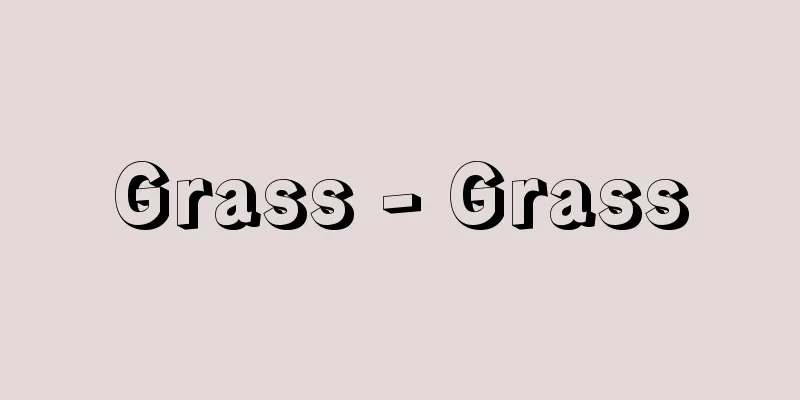Grass - Grass

|
The opposite of tree. Unlike trees, there is a limit to the growth of the above-ground parts, they are smaller and shorter-lived than trees, and their stems are soft and not woody. They are also called herbs. Grasses are considered to be a more evolved life form than trees due to their geographical distribution and anatomical characteristics of their stems, and are generally thought to have evolved from primitive trees. It is believed that the evolution of grasses was promoted by the cooling of the earth. As a result of the suppression of tree growth, life forms such as vines and shrubs were born, and then primitive perennial herbs that reproduce early were born. Grasses can survive the cold unsuitable period with underground organs and resistant seeds, so they eventually spread to the north and high mountains. Approximately 54% of the Japanese flora is considered to be herbs. Grasses are divided into ephemerals, annuals, biennials, and perennials depending on the length of their growing period. The purpose of classifying herbaceous plants into life forms such as dormant and growing types is to ecologically classify herbaceous plants. Grasses are also divided into weeds, which are particularly adapted to human disturbance, wild grasses, which are not, and village plants, which are in between, based on the strength of their relationship with humans. Communities in which grasses dominate the physiognomy (the appearance of a plant group) are collectively called grasslands. There are natural grasslands that are established due to climatic and habitat conditions, semi-natural grasslands that are maintained by humans through regular mowing and burning, and artificial grasslands (grasslands) that are created by humans by sowing grass seeds. Grasslands can be in the transitional phase or in the climax phase. Grasslands can also be divided into grassland and broadleaf grassland based on the life cycle of the dominant species, and the two types use light differently. [Masahiko Osawa] Source: Shogakukan Encyclopedia Nipponica About Encyclopedia Nipponica Information | Legend |
|
木の対語。木と違って地上部の成長に上限があり、木よりも小形、短命で、茎は木化せず柔らかい植物。草本ともいう。草は、その地理分布の特徴、茎の解剖学的特徴などから、木よりも進化した生活型群とみなされ、一般的には、原始的な木から草が生まれたと考えられている。草の進化を促したのは地球の低温化と考えられている。樹木の成長抑制の結果、つる植物や低木といった生活型が生まれ、さらに生殖時期が早い原始的な多年生草本が生まれた。草という体制では、寒冷な不適期を地下器官や耐性のある種子で生き延びられるために、やがて北方や高山などにもその分布を広げた。日本の植物相では約54%が草本とされている。草には、その生育期間の長さによって短命草(エフェメラル)、一年草、二年草、多年草の区別がある。休眠型や生育型といった生活型の分類は、草本植物の生態学的類型化をその目的としている。また、草は人間とのかかわりの強さから、とくに人為的な攪乱(かくらん)に適応的な雑草とそうでない野草、その中間的な人里植物が区別される。草が相観(植物集団の姿)を支配している群落は草原と総称される。気候条件、生育地条件によって成立する自然草原、人間が定期的に刈り取りをしたり、火入れをすることで維持される半自然草原、人間が草の種子を播(ま)いて造成する人工草原(草地)がある。草原には遷移の途中相のものと極相のものとがある。また優占種の生活型によってイネ科型と広葉型の草原が区別され、両者は光の利用の仕方が異なる。 [大澤雅彦] 出典 小学館 日本大百科全書(ニッポニカ)日本大百科全書(ニッポニカ)について 情報 | 凡例 |
Recommend
Star
〘 noun 〙 (star)① A star. A star symbol. A star mar...
Locomotive Workers' Union - Kikansharoudoukumiai
...In June 1989, the official name was changed to...
Gauss-Laplace theorem - Gauss-Laplace theorem
This is also known as the de Moivre-Laplace theore...
Donax (English spelling) Donax cannaeformis (Forst.) Schum.
A shrub-like perennial plant of the Aragonaceae fa...
Noncompliance
… [Blood levels during drug therapy] It is often ...
Phillipsiidae
...The number of Phacops species decreased from t...
Willow strawberry - Willow strawberry
A deciduous shrub of the Urticaceae family that is...
Eurasia - Eurasia (English spelling)
The term used when both Asia and Europe are consi...
Conquest of Choshu
The Tokugawa shogunate dispatched troops to the C...
Crater basin
A flat lowland located between the outer rim and ...
Alnus crispa (English spelling) Alnus crispa
…[Hiroshi Aramata]. … *Some of the terminology th...
Jaguar - Jaguar (English spelling)
It is a member of the order Carnivora and family ...
Ansei Provisional Treaty
→ Ansei Five-Nation Treaty Source : Heibonsha Ency...
Tax saving
...Actions aimed at reducing the tax burden of ta...
Kock, Charles-Paul de
[Born] May 21, 1793, Passy Died: April 27, 1871. F...





![Seto [city] - Seto](/upload/images/67cc05aad9e9c.webp)



